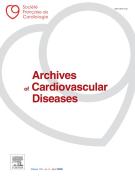First experience of intraoperative echocardiography-guided optimization of cardiac resynchronization therapy delivery - 17/04/14
 , Philippe Ritter b, Jean-Claude Daubert c, Serge Cazeau a
, Philippe Ritter b, Jean-Claude Daubert c, Serge Cazeau aSummary |
Background |
Insufficient correction of mechanical dyssynchrony is a cause of non-response to cardiac resynchronization therapy (CRT).
Aims |
To determine if CRT delivery could be optimized during the implantation procedure by choosing the number and location of pacing sites using echocardiography guidance.
Methods |
In patients with a QRS≥150ms or a QRS<150ms and criteria for mechanical dyssynchrony, the objective of the implantation procedure was to shorten the left pre-ejection interval (LPEI), measured online, by at least 10ms compared with standard biventricular configuration, by moving the right ventricular (RV) lead at different locations and, if necessary, by adding a second RV lead.
Results |
Ninety-one patients (70 men; mean age 73±10 years; left ventricular [LV] ejection fraction 29±10%) were included. The final pacing configuration was standard biventricular in 15 (17%) patients, optimized biventricular in 22 (24%) and triple-site ventricular in 54 (59%). LPEI was shortened by ≥ 10ms compared with standard biventricular stimulation in 73 (80%) patients. Compared with standard biventricular pacing, the final optimized pacing configuration improved global intraventricular synchrony (decreasing LPEI from 158±36ms to 134±29ms; P<0.001), LV systolic efficiency (decreasing LPEI/LV ejection time from 0.58±0.18 to 0.46±0.13; P<0.001) and LV filling (increasing LV filling time/RR from 44±8% to 47±7%; P<0.001) and decreased mitral valve regurgitation.
Conclusion |
Intraoperative echocardiography-guided placement of RV lead(s) during CRT implantation is feasible and acutely improves LV synchrony compared with standard biventricular stimulation.
Le texte complet de cet article est disponible en PDF.Résumé |
Contexte |
La correction insuffisante de la désynchronisation mécanique est une cause de non-réponse à la thérapie de resynchronisation cardiaque (CRT).
Objectif |
Déterminer si la CRT est optimisable durant l’implantation en faisant varier le nombre et le site de stimulation par guidage échocardiographique.
Méthodes |
Chez des patients avec un QRS≥150ms ou avec un QRS<150ms et une désynchronisation mécanique, l’objectif de la procédure d’implantation était de raccourcir le délai pré-éjectionnel gauche (LPEI), mesuré en temps réel, de ≥10ms par rapport à la configuration biventriculaire standard, en déplaçant la sonde ventriculaire droite (VD) et si nécessaire en ajoutant une seconde sonde VD.
Résultats |
Quatre-vingt onze patients (70 hommes ; âge 73±10ans ; FEVG 29±10 %) ont été inclus. La configuration de stimulation finale était biventriculaire standard chez 15 (17 %) patients, biventriculaire optimisé chez 22 (24 %) et triple-site ventriculaire chez 54 (59 %). L’objectif a été atteint chez 73 (80 %) patients. Comparée à la stimulation biventriculaire standard, la configuration de stimulation finale, optimisée, a amélioré la synchronisation intraventriculaire globale (LPEI raccourci de 158±36ms à 134±29ms ; p<0,001), l’efficience systolique du ventricule gauche (VG) (LPEI/temps d’éjection VG diminuant de 0,58±0,18 à 0,46±0,13 ; p<0,001), le remplissage VG (remplissage VG/RR augmentant de 44±8 % à 47±7 % ; p<0,001) et a diminué l’insuffisance mitrale.
Conclusion |
Le guidage de la mise en place de la (des) sonde(s) VD durant l’implantation de la CRT par une échocardiographique peropératoire est faisable et améliore en aigu la synchronisation VG comparé à la stimulation biventriculaire standard.
Le texte complet de cet article est disponible en PDF.Keywords : Cardiac resynchronization therapy, Mechanical dyssynchrony, Left pre-ejection interval, Intraoperative echocardiography, Triple-site ventricular stimulation
Mots clés : Thérapie de resynchronisation cardiaque, Désynchronisation mécanique, Délai pré-éjectionnel gauche, Échocardiographie peropératoire, Stimulation triple-site ventriculaire
Abbreviations : CRT, DDD, IVMD, LPEI, LSWMD, LV, LVEF, LVET, LVFT, MVRS/LAS, NYHA, RPEI, RV, TDS
Plan
Vol 107 - N° 3
P. 169-177 - mars 2014 Retour au numéroBienvenue sur EM-consulte, la référence des professionnels de santé.

